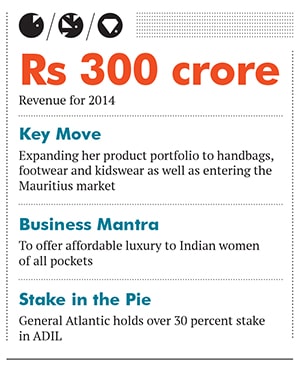
And Designs India: Affordable Luxury for Young India
Using affordable luxury as her plan, Anita Dongre has developed one of India's most commercially viable designer brands
I love the new young Indian woman. She is educated, works, has seen the world, knows what she wants and demands it,” says Anita Dongre. This clarity about her client base has helped Dongre transform And Designs India Ltd (ADIL), founded in a single room in 1998, into a company valued at nearly Rs 700 crore. It notched revenues of Rs 275 crore in 2012-13 and over Rs 300 crore in 2014, with same-store-sales growing by 30 percent year-on-year.
ADIL has evolved into one of India’s most commercially viable designer brands. Its portfolio includes prêt brands AND and Global Desi, signature label Anita Dongre, and sub-brands, Timeless and Iinter-pret. Currently, ADIL has 550 retail points and aims to open at least two to three stores (AND and/or Global Desi) every month this year; it is also targeting new cities like Kochi, Guwahati and Mohali.
With a global private equity fund on her side, expansion is not an issue. Late last year, General Atlantic acquired more than 30 percent stake in ADIL: It bought the 23 percent held by the Kishore Biyani-owned Future Ventures and around 10 percent more.
THE WOMAN BEHIND IT
In the 1990s, Dongre was supplying embroidered apparel to boutiques in Mumbai. “But there was no Anita Dongre signature on them—my creativity was getting stifled,” she says. That was when, in 1999, she launched AND, a contemporary Western wear brand, and, over the next nine years, created the Global Desi and Anita Dongre lines as well.
Her biggest accomplishment, though, has been the ability to recognise and occupy the affordable luxury plank that other top designers had ignored. Instead of sticking to high price points, Dongre decided that “every pocket should be able to buy my brand”. “Fashion is dominated by women; I want every girl in India to wear my clothes and feel like a million bucks,” she says, dismissing the notion of brand dilution. “It’s not about the brand, it’s about the style and that can be made affordable. I will never make a Rs 10-lakh lehenga.”
To expand her portfolio, she plans to introduce other products such as handbags and footwear. Last August, Dongre set up Pinkcity, a bespoke gold jadau and meenakari jewellery line, that is retailed from the Anita Dongre flagship store in Lower Parel and Jet Gems in Bandra, with prices going up to Rs 15 lakh. “I want to take Pinkcity to the world. I want to see it at Tiffany’s and Harrods,” she says.
That ambition also hints at her long term plan for ADIL: Turning it into India’s biggest fashion house.

WHY IT IS A GEM
In India, very few fashion and luxury brands have been able to break the shackles of high prices. ADIL has achieved that without diluting its brand value or positioning.
“And Designs is a clear stand-out within women’s fashion on multiple parameters,” says Sandeep Naik, managing director, General Atlantic. “Highly differentiated product, very strong design capabilities, excellent brand recall, strong execution on store roll-out, besides being stellar on financial metrics like profitability and return on capital.”
As he points out, Dongre has been consistently innovating to enhance her offerings. Geographically, too, there is significant scope for growth. “We believe brands like Global Desi and Anita Dongre are well-placed to expand into the Middle East, South-East Asia and even potentially the Western markets,” says Naik.
WHY IT WAS HIDDEN
ADIL, unlike several contemporaries, isn’t quite a household name yet. For one, ADIL is still niche and caters predominantly to an urban clientele. Also, unlike a Manish Malhotra or a Sabyasachi Mukherjee who have built their fame, in no small measure, due to Bollywood, ADIL has relied on its in-store offerings. The company does not have a brand ambassador although it does its share of print advertising.
Though the company has now started an online store, it has to learn to cater to the very strong non-resident Indian community and build its presence in Dubai and London.
RISKS & CHALLENGES
ADIL is all about Dongre right now. She is the life of the brand and the business is dependent on her. Can the company grow beyond Dongre’s creativity and persona? That assumes significance as ADIL achieves greater scale. Further, ADIL is surrounded by competitors in all its categories; in Western wear, from global players like Zara, Mango and Only who also have deep pockets; in fusion wear, from W and Fabindia; and in luxury, Manish Malhotra and JJ Valaya among others.
Finally, ADIL’s ambitions are unique in that India doesn’t have the precedence of a large fashion house with a sweeping presence across product categories. But in this too, Dongre will aim to set the trend.
(This story appears in the 30 November, -0001 issue of Forbes India. To visit our Archives, click here.)






